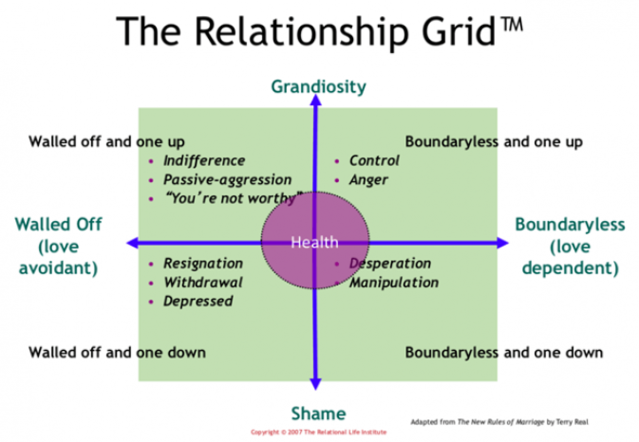Self-Esteem
How Boundaries and Self-Esteem Affect Your Relationships
Using the Relationship Grid to understand our personalities.
Posted October 29, 2021 Reviewed by Tyler Woods
Key points
- Thinking about relationship patterns in terms of self-esteem and shame can help us understand our behaviors and where relationships go wrong.
- The Relationship Grid was developed by therapist Terry Real and is a way to visualize where your primary maladaptive relationship style trends.
- No matter where you fall on The Relationship Grid, we should aim for the middle ground between extremes.
Do you find that your relationships are affected by poor boundaries and low self-esteem? Or do you perhaps have too many boundaries and too much self-esteem? We want to avoid these extremes: they cause problems when we try to form healthy relationships.
To help us understand relationship patterns and behaviors, we'll outline The Relationship Grid, developed by therapist Terry Real, which is a useful way to conceptualize where your primary maladaptive relationship style leans.
In this model, the horizontal axis represents boundaries and the vertical axis represents self-esteem.

Grandiosity vs Shame
Let’s start with the vertical axis, which measures self-esteem. The top of the axis is grandiosity, or “one up,” and the bottom is toxic shame, or “one down.” Shame and grandiosity are not opposite emotions—they are the same emotion pointed in opposite directions.
When the focus is outward, we're pretentious towards others. The grandiose person feels superior, better than, and worth more than another person. You are being grandiose whenever you look down on someone. Grandiosity means regarding someone judgmentally, not by their actions, but by character-based judgments (e.g. calling someone a fool or disgusting). You may also see grandiose people engage in offensive slurs for various groups of people.
On the opposite end of the axis is toxic shame. This is when this contempt is pointed inward. As opposed to appropriate shame, which is when it makes sense to feel bad about something based on your actions, toxic shame is how we make ourselves feel less than. In many ways, we can treat ourselves like we are disgusting or unfit to be around other humans. Many of the things that a grandiose person would say to others, a person filled with toxic shame will say to themselves. When we are filled with toxic shame, we believe that we are worthless and that our needs are always secondary.
In essence, you have too much shame if you land on the toxic shame side of things and too little shame if you land on the grandiose area.
Boundaryless vs. Walled Off
On the horizontal axis or the boundary line, we have "walled off" and" boundaryless." Those who are boundaryless have never developed healthy boundaries. If you are boundaryless, you end up being too prone to emotional contagion. You absorb everything everyone else is feeling and can easily become overwhelmed. You may depend on external validation to an inappropriate degree, which can lead to impulsive behaviors to avoid relationship problems.
When you are walled off, your boundaries are impenetrable. No one gets in and no one gets out. You’re so afraid of getting hurt or being engulfed by others' experiences that you put up walls that make it impossible for anyone to get close to you.
Essentially, on this axis, you either have too few boundaries or too many.
The four quadrants
Now that we understand the two axis of The Relationship Grid, let's take a look at the four quadrants they create. Knowing which quadrant you fall in can help explain how you approach relationships.
Bottom Left: Walled Off and Shameful
In its most extreme form, this quadrant is represented by resignation and depression. People in this quadrant typically feel so awful about who they are that they often don’t feel as though they're worthy of relationships with other people. They put a wall between themselves and others because they're ashamed about what others might discover if they really got to know who they are. They assume that others would despise them. They might engage in pessimistic thinking about their ability to connect to others. People in this quadrant might present as withdrawn, disengaged, or depressed.
Upper Left: Walled Off and Grandiose
In its most extreme form, this quadrant is represented by meanness and entitlement. This person feels like they are above others. This type might believe that they are always right and seek the last word. They may also be snobbish, elitist, racist, and passive-aggressive.
In general, they are mean-spirited and cruel. Unfortunately, people who primarily land in this quadrant will not see themselves as the problem, despite the fact that living in this way leads to a very lonely existence.
Upper Right: Boundaryless and Grandiose
In its most extreme form, this quadrant is represented by control and violence. This is a maladaptive style that can lead to abuse in relationships. Signature features may include being controlling, retaliation, verbal attacks, lashing out in anger, and impulsiveness, all of which could be taken to the extreme with violence and abuse. They are determined to keep the relationship at all costs and often feel justified in using these behaviors because they feel victimized by their partner.
Lower Right: Boundaryless and Shameful
In its most extreme form, this quadrant is represented by desperation and neediness.
This is the classic people pleaser, the enabler. People in this quadrant might present as needy, clingy, and as though they would do anything to get someone to love them. They are desperate for others to validate them. People can become overwhelmed by the pursuer's constant needs and will attempt to create distance which only leads to the pursuer trying harder to get their needs met.
What do healthy boundaries and self-esteem look like?
After hearing all of this and understanding The Relationship Grid, you may be wondering what healthy boundaries and self-esteem look like. As in most things in life, you are looking for the middle ground between all of these extremes.
If you find that you are in a shameful state, look for opportunities to build confidence and be vulnerable when it’s safe to do so. This can take many forms, but you could use positive affirmations or engage in activities that make you feel like a capable person. If you are in a grandiose state, attempt to take the viewpoints of others into consideration, invest in being nonjudgmental, and practice nonviolent communication.
If you are walled off, try getting uncomfortable. Look for opportunities to be authentic with those around you.
If you are boundaryless, take a step back and consider what your boundaries are in a situation, or what common boundaries someone might have in this situation.
Remember, we want to avoid the extremes in all of these quadrants, as they lead to problems in our ability to connect with others in healthy ways.




